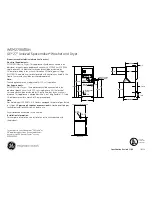
16
Maytag Co.
112204 - 2
Electrical Shock Hazard
Disconnect power before servicing.
Replace all parts and panels before operating.
Failure to do so can result in death or electrical
shock.
NOTE:
To prevent damage, avoid cleaning and/or touching
ignitor/flame-probe assembly.
Remove lint from gas valve burner area with a dusting brush
or vacuum cleaner attachment.
Clean any lint accumulation in and around the motor(s)
casing opening.
Every 6 Months
Inspect and remove lint accumulation in customer furnished
exhaust ductwork system and from dryer’s internal exhaust
ducting.
NOTE:
Do not obstruct the flow of combustion and
ventilation air. Check back draft dampers in the exhaust
ductwork. Inspect and remove any lint accumulation,
which can cause the damper to bind or stick.
A back draft damper that is sticking partially closed can
result in slow drying and shutdown of heat circuit safety
switches or thermostats.
When cleaning the dryer cabinet, avoid using harsh
abrasives. A product intended for the cleaning of
appliances is recommended.
!
WARNING
Selection (setting) changes can be made at any time during
the drying cycle.
Shutdown Instructions ________________
If the dryer is to be shutdown (taken out of service) for a
period of time, the following must be performed:
Discontinue power to the dryer either at the external
disconnect switch or the circuit breaker.
Discontinue the fuel supply: close external gas shutoff valve.
Also close internal gas shutoff valves.
Disconnect the hose to the S.A.F.E. system. Unscrew the
3/4” 11.5 NH hose adapter to the 3/8” N.P.T. water connection
located at the upper rear of the dryer as well as the coupling
seated on the supply valve.
Service/Parts Information ____________
Service
Service must be performed by a qualified trained technician,
service agency, or gas supplier. If service is required, contact
the Maytag distributor from whom the equipment was
purchased. If the distributor cannot be contacted or is
unknown, contact the Maytag Co. for a distributor in your
area.
NOTE:
When contacting the Maytag Co., ensure to give
the correct model number and serial number so that your
inquiry is handled in an expeditious manner.
Parts
Replacement parts should be purchased from the distributor
from whom the Maytag equipment was purchased. If the
distributor cannot be contacted or is unknown, contact the
Maytag Co. for a distributor in your area or visit:
www.maytagcommerciallaundry.com and click on distributor
locator.
NOTE:
When ordering replacement parts from the Maytag
distributor or the Maytag Co. be sure to give them the
correct model number and serial number so that your parts
order can be processed in an expeditious manner.
Routine Maintenance _________________
Cleaning
A program and/or schedule should be established for periodic
inspection, cleaning, and removal of lint from various areas
of the dryer, as well as throughout the ductwork system. The
frequency of cleaning can best be determined from
experience at each location. Maximum operating efficiency
is dependent upon proper airflow. The accumulation of lint
can restrict this airflow.
NOTE:
Suggested time intervals shown are for average
usage, which is considered 6 to 8 operational (running)
hours per day.
Every 6 months, inspect the exhaust ducting and remove
any lint buildup.
Suggested Cleaning Schedule
Every Third or Fourth Load
Clean the lint screen every third or fourth load. A clogged lint
screen will cause poor dryer performance. The lint door/
drawer is located just below the loading door of the dryer.
Open the lint drawer, brush the lint off the lint screen, and
remove the lint. Inspect lint screen and replace if torn.
NOTE:
To remove the lint drawer from the dryer, pull the
drawer out loosen the torx screws on the sides of the rails.
This allows the metal clips to rotate and allow the drawer to
be fully removed. Reverse the above process for
installation.
IMPORTANT:
The frequency of cleaning the lint screen
can best be determined from experience at each location.
Weekly
Clean lint accumulation from lint chamber, thermostat, and
microprocessor temperature sensor area.
90 Days


































